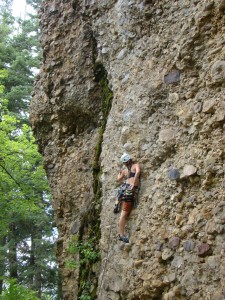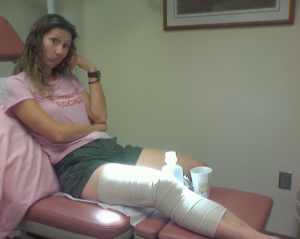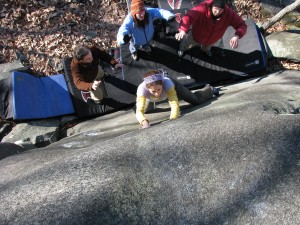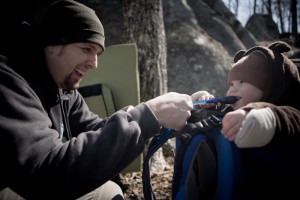A Perspective on Risk Assessment
“Do you take less risks in climbing now that you’re a mom?”
If I had a dollar for every time someone has asked me this since Cragbaby entered on the scene…well let’s face it, I wouldn’t be rich, but I would definitely be able to buy more $4 frappucinnos at Starbucks! The funny thing is, I never really feel like I have a good answer for this question. I feel like the “correct” answer is, “Yes, the responsibility of raising a little person has made me less risky of a climber.” But if I’m being honest, I don’t really think much has changed with regards to my risk assessment. But before you start throwing stones, let me explain.
In a sport where certain mistakes can be fatal, no one can argue that rock climbing is a sport without risk. But with the advances in modern equipment, along with proper knowledge of that equipment’s uses and limitations, a lot of those risks can be mitigated to an acceptable level. It’s not something I dwell on, but this concept of acceptable risk has been in the back of my mind ever since I started climbing, not just once C came along. When my husband and I first started climbing in 2006, we had lots of discussions about risk and consequences. We made a pact that if either of us was ever in a situation where our risk of danger felt higher than what we were comfortable with, we would bail as quickly and as safely as we could, no matter how many thousands of dollars of gear we had to leave behind, or how close we were to the summit. That hasn’t changed since Cragbaby came along.
But enough about epic scenarios – what about everyday situations? As far as the spectrum of climbers goes, some would probably say we were more on the conservative side to begin with, so again – not much has changed. My risk assessments pre-Cragbaby as wife, daughter, and friend are still right in line with where they are now as a climbing Mommy. I feel like my attitude can be for the most part be boiled down to one statement, and applied in different ways depending on particular situation.
BE OKAY WITH THE CONSEQUENCES OF A FALL.
Take the following scenarios for example.
1. Topropes – If I or someone else that I trust has set up the anchor, I will gladly flail away on a toprope of just about any grade.
2. Sport Routes – If the route is bolted well and the fall zones are safe, I’ll go for it. Yeah, I’ve taken a few nasty falls while lead climbing, including one that landed me in the ER on our first day in Maple Canyon a couple of years ago. But it was a routine fall that I could take a million more times without incident – nothing “went wrong,” my belayer didn’t make a mistake…my knee was in the wrong place at the wrong time and bashed into a cobblestone that was jutting out from the rock. The consequences weren’t pleasant, but the experiences I had on that trip were well worth the stitches and brief weeks of physical setback. As my friend Brian wrote recently, “Sometimes we fall.”
3. Trad – I am a self-proclaimed trad pansy. I am willing to lead a full number grade higher (often times even more) on bolted routes than I am on gear routes. In new areas, I tend stick to easier grades where I can place the gear I need in a (relatively) relaxed body position. If I’m gonna push myself, it’s going to be on a route on which I’m familiar and comfortable with the gear placements, or a crack with obvious placements from the ground.
4. Bouldering – It all boils down to the landing – if its well-protected with pads or spotters that I trust, I’ll go for it. If not, I don’t – simple as that.
5. Free-soloing – No matter how comfortable I feel at the grade, or how solid the rock is, there are always factors out of my control – holds can break, swarms of bees can attack (it’s happened to me on a rope, I’m assuming it could happen without one too…). Since I’m not okay with the fall consequences, its not for me – not pre-Cragbaby, and certainly not now! (Doesn’t mean that I don’t have several friends who choose otherwise, and more power to them – I’ll cheer them on with gusto. But you won’t catch me doing it.)
What a lot of non-climbers don’t think about when they ask me the “risk question” is that this concept of risk and consequences is not only applicable to climbing. I’d be willing to bet more than a few of my aforementioned $4 frappucinos that each and every one of us makes decisions based on risk every day, whether it be consciously or subconsciously. When you’re running late do you give in to the temptation of driving too fast, risking an accident, or do you stay the speed limit and risk being late? How many of us think about the risks of getting on an airplane, swimming in the ocean, or not wearing sunscreen before we do it? Most people don’t think about the risks to these everyday activities, but that doesn’t mean they don’t exist!
So has my attitude about risk changed since Cragbaby entered the scene? Not really. Yes, he is one of God’s greatest gifts to me, but every member of my family is WAY more important to me than my climbing ever could be, so his arrival has merely solidified the attitude I already had on risk. There are a lot of things about my life that I cannot control, but what I can do is evaluate my actions and choices, make sure that I can accept all possible outcomes of those choices, (both on and off the rock) – then commit to those choices wholeheartedly, and climb on! 🙂






22 Responses to “A Perspective on Risk Assessment”
I’m really glad you feel this way. And yes, if all of us are honest, there lots of common ways that non-climbing folks can engage in “riskier than necessary” behavior. Great Post. It’s a subject we all should evaluate every now and then.
Very good post Erica. In my own experiences what I have found is that the greatest risk comes when you venture into the unknown. If I free solo something that I have done before I know what to expect and how my abilities stack up to it and I can make a valid judgement as to the risk. If I climb a route new to me though that’s not well documented I may run into something that really is beyond my abilities but is poorly protected. That has happened a few times when the X factor has gotten way to high.
X = (probability of a fall)*(consequences of a fall)
RT @ericalineberry Many non- #climb ers don’t consider own risk taking. ie When running late do you drive too fast? http://bit.ly/hegkn7
Nice post, and I agree. I’ve always managed the risks in climbing and the kids haven’t really changed that. I might be a bit more averse to higher risk (I don’t highball as much as I used to), but I think that’s mainly because my opportunities to get out are more limited as I balance family and climbing and if I get hurt I don’t get as much time on the rock (says the guy with the sprained ankle).
how do you evaluate risks? @EricaLineberry discusses how she does it as a mom who loves to #climb – http://bit.ly/hegkn7
Nice blog post on #climb ing and risk from @EricaLineberry who reflects on assessing risk after cragbaby came along: http://bit.ly/hegkn7
@Emil – I like the X factor equation, thats a good way to explain the calculated risk.
@gimpy, I mean Brian 🙂 – The sprained ankle is another perfect example about how risk management doesn’t mean that you never get hurt – glad it wasn’t any worse than it is though!
great post. i feel the same way. however, i didn’t start climbing until after i already had kids so i can’t really compare climbing risks before/after. but in general the climbing risks i take are far less dangerous than some of the other risks i took before having kids.
This is great! Thank you for sharing, I always enjoy your posts 🙂
I am a mother and a climber too, but didn’t climb at all before I had kids. But I think you are absolutely right, I don’t think my climbing would be any different either. It is safety first for me and my childless climbing partners.
Nicely put! Only difference for us from “before kids” and “after kids” is the “carry out” factor. We are that extra bit of cautious because we have to make sure that we can get both kids out. Before, we only had to worry about getting ourselves back to the car, so a sprained or broken ankle was workable. Now, I’ll back down from a high ball boulder problem or sketchy lead fall because I know my husband can’t carry me out with both kids (and vice versa).
Nice risk assessment piece from @EricaLineberry http://ow.ly/4xSQO @aleyajean don’t you have a piece on risk/fear? I can’t find it now. Ugh.
An especially great read for all our climbing mommies! A Perspective on Risk Assessment http://j.mp/hOpzDs @EricaLineberry via @AddToAny
I enjoyed reading this very thoughtful post, Erica. Thanks.
@Haley and @Krysia – Thanks for the comments…its interesting to hear the perspective from folks that learned to climb POST kiddos. I bet you both got the “Why are you doing such risky things?” bit from a your share of friends when you first started!
@Laura – Interesting perspective on the “carry-out” factor. We aren’t to the stage where just the three of us can go out climbing together as a family, so we haven’t had to think about that yet – soon enough though, I’m sure!
Nice post, Erica. I think that by embracing risk in climbing we’re more attuned to the risks inherent in life, and can appreciate the small things more because of it. That’s one of the ways I feel climbing has changed my life for the better. Besides, my life would be pretty boring without climbing, and what’s the worse evil: to live with risk and accept it or to live in fear and not do the things that inspire you?
great post, i think more climbers should discuss risks. its something we dont want to talk about b/c of a possible jinx I guess, but its something we shouldnt just set aside as a warning label that comes with our gear and assume we all acknowledge and accept it. By discussing risks and failures we all learn.
This is something that I’ve thought about a lot in terms of climbing with Matt. For some reason, the stakes seem a lot higher and mistakes that much more scary (even if not life-threatening) when we’re climbing together than they would otherwise. I try not to think about worst-case scenarios too much and just make sure that we’re prepared, but there are definitely times when he’s leading something new and challenging and I’m at the bottom white-knuckling the rope and following each of his movements without blinking. I catch myself during those moments and remind myself to relax. Then I wonder if I would be as tense belaying someone else. I’m still a relatively ‘new’ climber (about 2 years), and I’m fairly certain that this will get better with time. And, I wouldn’t trade the experience of climbing with Matt for anything. Great post, Erica. You really got me thinking!
great share, erica. i have to respond to the very same questions regarding my climbing risk assessment as it regards to my responsibilities of parenting. non climbers lack the necessary context: our climbing skill and judgment evolves over time and in ‘baby-steps’. you rarely hear nascar heroes getting questions about their risky lifestyle as it applies to parenting. maybe its because they get rich from their racing success, while we climbers just get soulful fulfillment from our sends.
Very well said Erica. I’ve been thinking about this topic quite a bit as this is my first rock season as a dad.
Great post Erica! My .02 cents is that people who have to ask that question are either 1.) non-climbers who think rock climbing is scary dangerous and that death is eminent the moment your feet leave the ground or 2.) other climbers who consciously make risky decisions while climbing.
I’m a big weanie myself when it comes to climbing- mostly because I like my life and my body in one piece and I can’t stand the idea of pain from an injury. I just don’t choose to take unnecessary risks when I’m climbing. In fact, sometimes, I refuse to take even reasonable risks and it hampers my progress, but that’s another story. I’m not a mom, but if I did have kids one day, I wouldn’t feel that I need to change or “tone down” my climbing in anyway for my child’s sake either.
When the unthinkable happens though, I think its that first group of people that perceive a mother as being irresponsible for climbing at all. I think about what happened to Alison Hargreaves when she died on K2. She was branded irresponsible by the non-climbing media who felt that she had no business being on a mountain like K2 in the first place when she had kids at home. Contrast that with Alex Lowe’s death in the Himalaya a few years later. He left two young sons behind (with their mother) but nobody questioned his integrity as a father or called him irresponsible or reckless for leaving his kids behind.
So here’s a question- do people ask your husband if he takes less risks now that he’s dad? Perhaps this question belies a hidden current of sexism that still exist in the climbing community?
David – Best of luck as a Crag-Daddy and welcome to the club!
Christa – You bring up some good points. I definitely agree that many times our society is more quick to label a mom as irresponsible than a dad. As far as my husband and I go, I think if the question comes from climbers its usually directed at both of us…the “mom only” version usually happens in non-climbing circles, for whatever reason…
Hi there, yeah this paragraph is really fastidious and I have learned lot of
things from it about blogging. thanks.